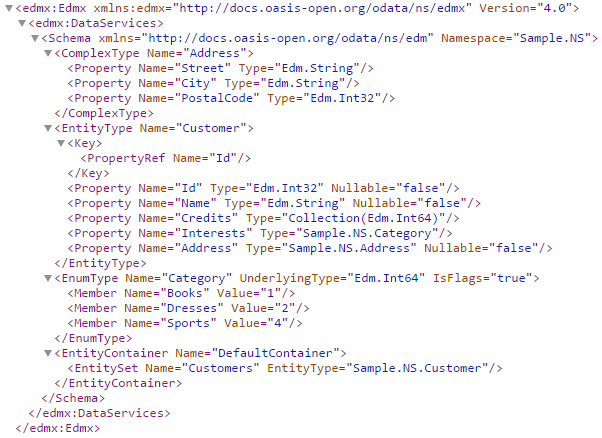Read and write models(ODL V6.x)
Applies To: # OData Core lib v6 supported OData Core Lib V6
OData Core Lib V6
Models built with EdmLib APIs are in object representation while CSDL documents are in XML representation. The conversion from models to CSDL is accomplished by the CsdlWriter APIs which are mostly used by OData services to expose metadata documents (CSDL). In contrast, the conversion from CSDL to models is done by the CsdlReader APIs which are usually used by OData clients to read metadata documents from services.
This section shows how to read and write entity data models using EdmLib APIs. We will continue to use and extend the sample from the previous section.
We have already used one of the APIs to write the model to a CSDL document in the last section.
namespace EdmLibSample
{
class Program
{
...
private static void WriteModelToCsdl(IEdmModel model, string fileName)
{
using (var writer = XmlWriter.Create(fileName))
{
IEnumerable<EdmError> errors;
model.TryWriteCsdl(writer, out errors);
}
}
}
}
The CsdlWriter.TryWriteCsdl() method is defined as an extension method to IEdmModel:
namespace Microsoft.OData.Edm.Csdl
{
public static class CsdlWriter
{
...
public static bool TryWriteCsdl(this IEdmModel model, XmlWriter writer, out IEnumerable<EdmError> errors);
...
}
}
The second parameter writer requires an XmlWriter which can be created through the overloaded XmlWriter.Create methods. Remember to either apply a using clause to an XmlWriter instance or explicitly call XmlWriter.Flush() (or XmlWriter.Close()) to flush the buffer to its underlying stream. The third parameter errors is used to pass out the errors found when writing the model. If the method returns true (indicating write success), the errors should be an empty Enumerable; otherwise it contains all the model errors.
The other version of the CsdlWriter.TryWriteCsdl() method is:
namespace Microsoft.OData.Edm.Csdl
{
public static class CsdlWriter
{
...
public static bool TryWriteCsdl(this IEdmModel model, Func<string, XmlWriter> writerProvider, out IEnumerable<EdmError> errors);
...
}
}
This overload is called when the model to write contains referenced models. The referenced models need to be written into separate files. So the second parameter writerProvider takes a callback to create a different XmlWriter for each referenced model where the string parameter is the schema namespace of that model. A simple writerProvider would be:
public XmlWriter CreateXmlWriter(string namespace)
{
return XmlWriter.Create(string.Format("{0}.xml", namespace));
}
The CsdlReader APIs are defined as follows:
namespace Microsoft.OData.Edm.Csdl
{
public static class CsdlReader
{
public static bool TryParse(IEnumerable<XmlReader> readers, out IEdmModel model, out IEnumerable<EdmError> errors);
public static bool TryParse(IEnumerable<XmlReader> readers, IEdmModel reference, out IEdmModel model, out IEnumerable<EdmError> errors);
public static bool TryParse(IEnumerable<XmlReader> readers, IEnumerable<IEdmModel> references, out IEdmModel model, out IEnumerable<EdmError> errors);
}
}
The first overload is mostly used. The second and third overloads are similar to the first one except that they also accept one or more referenced models.
The first parameter readers takes a set of XmlReader each of which reads a CSDL document. The second paramter model passes out the parsed model. The third parameter errors passes out the errors when parsing the CSDL document. If the return value of this method is true (indicating parse success), the errors should be an empty otherwise it will contain all the model errors.
In the Program.cs file, insert the following code to the Program class:
namespace EdmLibSample
{
class Program
{
public static void Main(string[] args)
{
...
WriteModelToCsdl(model, "csdl.xml");
#region !!!INSERT THE CODE BELOW!!!
var model1 = ReadModel("csdl.xml");
WriteModelToCsdl(model1, "csdl1.xml");
#endregion
}
...
private static IEdmModel ReadModel(string fileName)
{
using (var reader = XmlReader.Create(fileName))
{
IEdmModel model;
IEnumerable<EdmError> errors;
if (CsdlReader.TryParse(new[] { reader }, out model, out errors))
{
return model;
}
return null;
}
}
}
}
This code first reads the model from the CSDL document csdl.xml and then writes the model to another CSDL document csdl1.xml.
Build and run the sample. Then open both the csdl.xml file and the csdl1.xml file under the output directory. The content of csdl1.xml should look like the following:

You can see that the contents of csdl.xml and csdl1.xml are exactly the same except for the order of the elements. This is because EdmLib will reorder the elements when parsing a CSDL document.